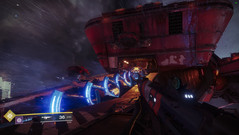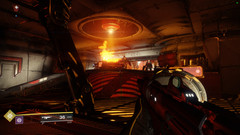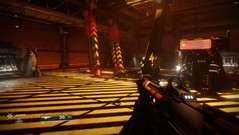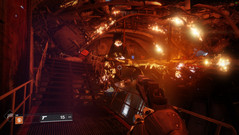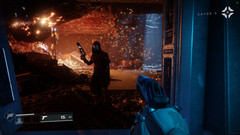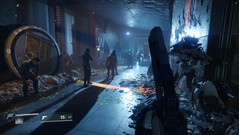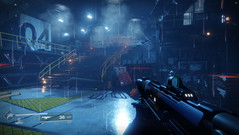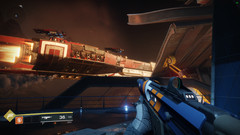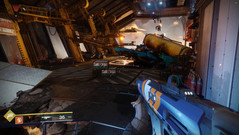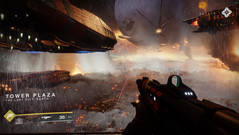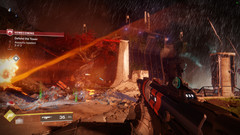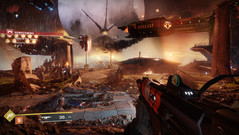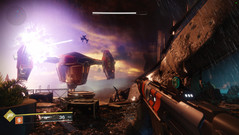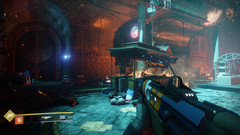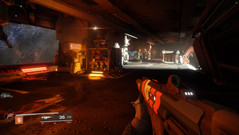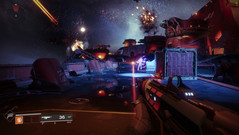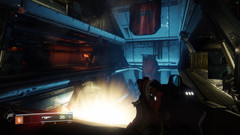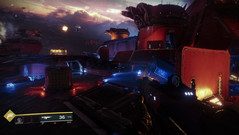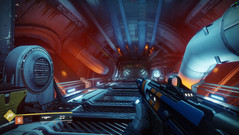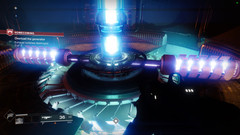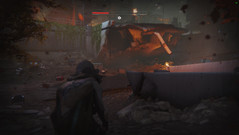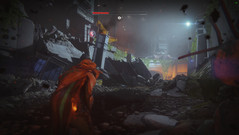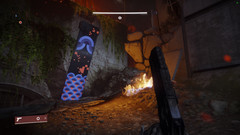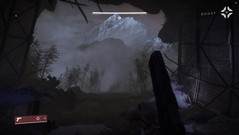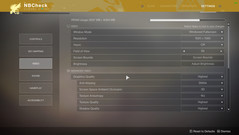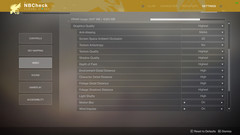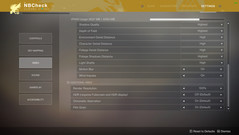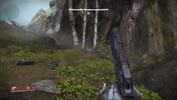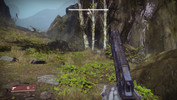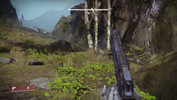Destiny 2 Laptop and Desktop Benchmarks
Technology
For the original German review, see here.
The developer Bungie, famous for its Halo games, now offers a sequel to the popular online shooter from 2014. Similar to Destiny 1, the second part of the science-fiction saga comes blasting like a fireworks display in a Hollywood-style enactment. The utilized engine shows its strength particularly well in regard to the quality of the effects. After a couple of minutes, we were already psyched about the excellent fire and smoke effects that are accompanied by the beautifully realistic rain in outdoor scenes. We also like the visual display of the weaponry and character abilities. Reflections appear exaggerated from time to time.
In combination with some jazzy level building blocks, Destiny 2 keeps reminding us of Unreal Tournament or, generally, games based on the Unreal Engine. Textures are very presentable and don’t have to hide behind other ego shooters, although a higher level of details would have been nice. The game levels leave us with a good visual impression thanks to the scenic environment which is for example decorated with chunks of debris.
We didn’t observe too much of a reduction in details when lowering the graphics settings, hence the game is still very enjoyable at lowest settings. On maximum settings, we would describe the visuals as good to very good. Gameplay-wise, we are really fond of the precise and smooth controls, which are even a bit better than what can be seen in the alphas among the shooters, like Call of Duty and Battlefield, and it even gives some games by id Software (Doom, Rage, etc.) a hard time keeping up.
Thanks to the uncomplicated gameplay and despite the bombastic effects, Destiny 2 runs smoothly, given adequate hardware equipment. The excellent tutorial, which is storied by great video sequences, makes it easy even for beginners to quickly get into the game. In the short time that we've played Destiny 2, we found it very intriguing, as it is simply a straightforward game. However, this very characteristic opens the possibility to make it seem uninspiring or even dull as players move forward to later levels.
We do have to voice praise about the very clean and good-looking game menus that are truly adapted for a PC version. The ample graphics options are praiseworthy as well, and they are categorized into three tabs: video for screen mode, resolution, VSync, field of view, screen limits and brightness, and additional video for render resolution (we always use 100%), HDR mode, chromatic aberrations, and noise filter.
Most options, however, can be found in the advanced video category. Players can choose between several presets for setting the graphics quality, but they can also individually customize the 13 available adjustments, including anisotropic filter or anti-aliasing. Like our recently tested games ELEX and Middle-earth: Shadow of War, Destiny 2 only offers FXAA and SMAA for moderate smoothing effects and slight blurriness.
What’s annoying is that a re-start of the game is required to change some settings, which gets even worse due to the long login process. The in-game VRAM display that shows the GPU’s graphics load is a very handy feature. In contrast to other Triple A games which are often hungry for more than 4 GB, Destiny 2 is very modest. On maximum settings at 1080p, the game requires a mere 2.7 GB. The game size of 35 GB (as of October 2017) is fairly standard.
Unfortunately, Destiny 2 is distributed and playable only via Blizzard’s gaming platform Battlenet, which rivals Steam, Origin, and UPlay. We did not experience significant lags, graphics errors, or freezes in our tests, but there were two things we did notice. For one thing, the screen remains black from time to time when changing the resolution. For another thing, Destiny 2 didn’t want to start into full-screen mode on laptops with Nvidia Optimus.
Benchmark tests
Destiny 2 is definitely not made for performance testing. Since overlay tools, like Frap, are blocked because of security reason (thanks to the modders and cheaters), which we do find to be unnecessary patronizing for the consumers, we could not measure the framerates the way we wanted. We had to rely on the implemented FPS display of the game but couldn’t record our experiences.
After a bit of research and thanks to the developers of the game, we found OCAT, an open-source alternative to Fraps. Although the overlay in OCAT did not work either, we could still assess the average framerates and since the game is a very quick ego shooter, 40 fps should be the minimum for players, but we find 60 fps or more to yield the best experience.
Results
Even though low-end GPUs like the Intel HD Graphics 630 can’t cope, the game’s hardware requirements are pretty moderate. The GeForce MX150, a graphics card from the lower mid-range segment, reaches 60 fps at a resolution of 1280x720 pixels.
For a Full HD experience in medium or high details, a GPU of the upper mid-segment (GeForce GTX 1050 or higher) is recommended. Maximum details in Full HD require at least a GeForce GTX 1050 Ti. For QHD (2560x1440 pixels), a GeForce GTX 1060 or GTX 980 and for 4K (3840x2160) a GeForce GTX 1080 (Ti) are good choices. In lower resolutions, the CPU is more of a bottleneck than the GPU for the framerate – which, by the way, is limited to a maximum of 200 fps.
| Destiny 2 | |
| 3840x2160 Highest Preset AA:SM AF:16x 2560x1440 Highest Preset AA:SM AF:16x 1920x1080 Highest Preset AA:SM AF:16x 1920x1080 High Preset AA:SM AF:4x 1920x1080 Medium Preset AA:FX AF:2x 1280x720 Low Preset | |
| NVIDIA GeForce GTX 1080 Ti (Desktop), 4790K | |
| NVIDIA GeForce GTX 1080 (Desktop), 6700K | |
| NVIDIA GeForce GTX 1080 Mobile, i7-7820HK | |
| NVIDIA GeForce GTX 1070 (Desktop), 6700K | |
| NVIDIA GeForce GTX 1070 Mobile, 6820HK | |
| NVIDIA GeForce GTX 980, 6700K | |
| NVIDIA GeForce GTX 1060 (Desktop), 6700K | |
| NVIDIA GeForce GTX 1060 Mobile, 6820HK | |
| NVIDIA GeForce GTX 1050 Ti Mobile, i7-7700HQ | |
| NVIDIA GeForce GTX 1050 Mobile, i7-7700HQ | |
| NVIDIA GeForce GTX 965M, 6700HQ | |
| NVIDIA GeForce GTX 950M, 6700HQ | |
| NVIDIA GeForce MX150, i7-7700HQ | |
| NVIDIA GeForce 940MX, 6700HQ | |
| NVIDIA GeForce 940M, 5700HQ | |
| NVIDIA GeForce 920M, 2970M | |
| Intel HD Graphics 630, i7-7700HQ | |
Overview
Test systems
| Device | Grahics card | Processor | Working memory | Operating system |
|---|---|---|---|---|
| Desktop-PC I | MSI GeForce GTX 1080 (8 GB GDDR5X) MSI GeForce GTX 1070 (8 GB GDDR5) Nvidia GeForce GTX 1060 (6 GB GDDR5) Nvidia GeForce GTX 980 (4 GB GDDR5) |
Intel Core i7-6700K | 2 x 8 GB DDR4 | Windows 10 64 Bit |
| Desktop-PC II | Nvidia GeForce GTX 1080 Ti (11 GB GDDR5X) Asus GeForce GTX 980 Ti (6 GB GDDR5) XFX Radeon R9 Fury (4 GB HBM) Sapphire Radeon R9 290X (4 GB GDDR5) Sapphire Radeon R9 280X (3 GB GDDR5) MSI Radeon R7 370 (2 GB GDDR5) |
Intel Core i7-4790K | 2 x 4 GB DDR3 | Windows 10 64 Bit |
| Alienware 17 R4 | Nvidia GeForce GTX 1080 (8 GB GDDR5X) | Intel Core i7-7820HK | 2 x 16 GB DDR4 | Windows 10 64 Bit |
| Asus G752VS | Nvidia GeForce GTX 1070 (8 GB GDDR5) | Intel Core i7-6820HK | 2 x 16 GB DDR4 | Windows 10 64 Bit |
| MSI GT62VR | Nvidia GeForce GTX 1060 (6 GB GDDR5) | Intel Core i7-6820HK | 4 x 8 GB DDR4 | Windows 10 64 Bit |
| MSI GE72 | Nvidia GeForce GTX 1050 Ti (4 GB GDDR5) | Intel Core i7-7700HQ | 2 x 4 GB DDR4 | Windows 10 64 Bit |
| Asus GL753VD | Nvidia GeForce GTX 1050 (4 GB GDDR5) | Intel Core i7-7700HQ | 2 x 8 GB DDR4 | Windows 10 64 Bit |
| MSI GL62 | Nvidia GeForce GTX 1050 (2 GB GDDR5) | Intel Core i7-7700HQ | 2 x 4 GB DDR4 | Windows 10 64 Bit |
| MSI GE72 | Nvidia GeForce GTX 965M (2 GB GDDR5) | Intel Core i7-6700HQ | 1 x 8 GB DDR4 | Windows 10 64 Bit |
| MSI PE60 | Nvidia GeForce GTX 950M (2 GB GDDR5) | Intel Core i7-6700HQ | 2 x 4 GB DDR4 | Windows 10 64 Bit |
| MSI PL62 | Nvidia GeForce MX150 (2 GB GDDR5) | Intel Core i7-7700HQ | 2 x 8 GB DDR4 | Windows 10 64 Bit |
| MSI CX72 | Nvidia GeForce 940MX (2 GB DDR3) | Intel Core i7-6700HQ | 2 x 8 GB DDR4 | Windows 10 64 Bit |
| MSI GP62 | Nvidia GeForce 940M (2 GB DDR3) | Intel Core i7-5700HQ | 1 x 8 GB DDR3 | Windows 10 64 Bit |
| MSI CX61 | Nvidia GeForce 920M (2 GB DDR3) | Intel Celeron 2970M | 1 x 8 GB DDR3 | Windows 10 64 Bit |
| Asus N551ZU | AMD Radeon R9 M280X (4 GB GDDR5) | AMD FX-7600P | 2 x 4 GB DDR3 | Windows 10 64 Bit |
| 4K Monitor | Nvidia drivers | AMD drivers |
|---|---|---|
| 2 x Asus PB287Q, Philips 328P6VJEB | ForceWare 388.00 | Crimson 17.10.2 |





